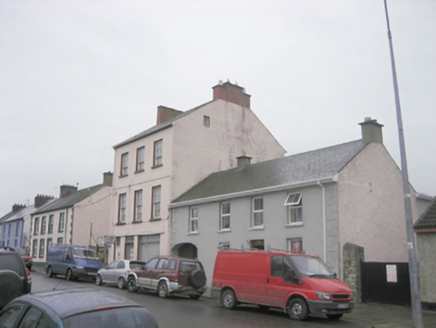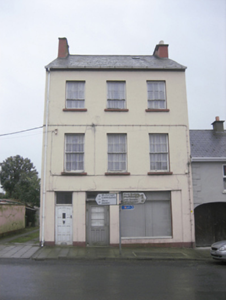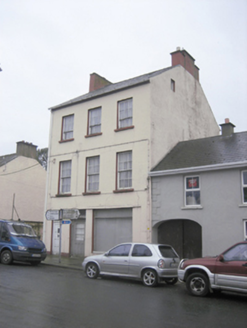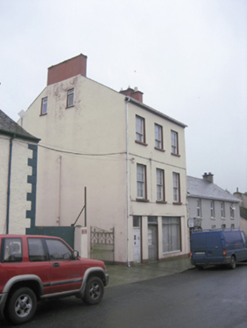Survey Data
Reg No
40830011
Rating
Regional
Categories of Special Interest
Architectural
Original Use
House
Date
1850 - 1890
Coordinates
234543, 409785
Date Recorded
28/09/2010
Date Updated
--/--/--
Description
Attached three-bay three-storey house with attic level, built c. 1870, having two-storey return extension to rear (south) and modern shopfront to the front elevation, c. 1980. Pitched natural slate roof with brick eaves course, some surviving sections of cast-iron downpipes, and with smooth rendered chimneystacks to the gable ends (east and west). Cast-iron rooflight to front pitch. Smooth rendered ruled-and-lined with painted plinth course. Square-headed window openings at first and second floor level with painted stone sills, and having six-over-six timber pane timber sliding sash windows. Square-headed door opening to east end of the front elevation having replacement timber door and plain overlight. Square-headed openings to former shopfront having fixed-pane display window and replacement timber door. Road-fronted to the centre of Saint Johnstown with adjacent four-bay two-storey building having integral carriage-arch attached to the west.
Appraisal
This plain but imposing three-storey building, probably originally dating to the second half of the nineteenth century, retains much of its original form and character despite the insertion of a later shopfront. Its visual appeal and integrity are enhanced by the retention of salient fabric such as the natural slate roof and timber sliding sash windows to the upper floors. This tall narrow building towers over the mainly long low two-storey buildings to the centre of Saint Johnstown and has a strong presence in the streetscape. It is also one of the few buildings in the centre of the town that retains much of its salient fabric, the other buildings having been replaced or incrementally altered over the years. This building is of a type that was, until recent years, a ubiquitous feature of the streetscapes of small Irish towns and villages but is now becoming increasingly rare. Although no longer in use, the building remains an integral component of the domestic built heritage of the locality, representing an early example of the typical mixed-use building form found in Irish towns. Sensitively restored, it would make a strongly positive contribution to the streetscape of Saint Johnstown.







